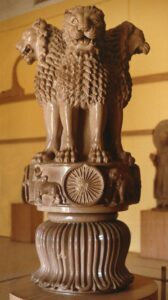Table of Contents
Lion Capital & Sanchi Stupa
Sanchi’s stupa is one of India’s very first and most important Buddhist sites. And some of the country’s oldest stone buildings can be found in this location. The British captain Edward Fell wrote one of the earliest accounts of the stupa of Sanchi in 1819. More specifically, it was claimed that Sir John Marshall’rediscovered’ the location 93 years after it had previously been “lost.” and afterwards another seven before it was changed to its present state. For UPSC preparation, the NCERT notes on the subject of “that is Sanchi Stupa & Lion Capital” are helpful.
Lion Capital & Sanchi Stupa Background
Beautiful caves and inscriptions illustrate Indian architecture from the Mauryan era, which began in the third century BCE, through the later mediaeval era’s fall, which began around the eleventh century CE. The Mahastupa, or Great Stupa, is rumoured to be the complex’s claim to fame. The Ashokan pillar features beautiful toran gateways and inscribed architecture.
The torans and the fencing are claimed to be designed in a manner that is similar to the bamboo craftspeople in the neighbourhood. If one pays close attention to the fencing around the stupa, it is possible to infer that the torans’ design is evocative of bamboo craft and that they are connected.
The Sanchi Stupa
The Mauryan dynasty played a very important part in the history of ancient India. The best specimen of Mauryan sculpture is the stupa in Sanchi. From the perspective of the Art & Culture section of the syllabus, understanding the stupa of Sanchi is crucial for the IAS.
We can assert with some interest that Lord Buddha never went to Sanchi. Neither did foreign tourists like Hiuen Tsang. He was the one who meticulously recorded the sacred Buddhist route in India. However, he hardly ever made reference to Sanchi in his writings. Marshall wrote about Sanchi, which was not as venerated as other Buddhist pilgrimage destinations in India, in his 1938 book The Monuments of Sanchi.

According to academics like Sir Alfred A Foucher, the iconic representations of Buddha at the Sanchi, such as the Bodhi tree, a horse without a rider, an empty throne, etc., are the result of Graeco-Buddhist architectural interaction. Sanchi’s lion capital is comparable to the one at Sarnath. The monument’s representation of Sanchi as an abacus rather than a chakra is the fundamental distinction between the two.
However, the Sanchi Stupa’s impact on our country’s mentality extends beyond the lion’s capital. Several contemporary structures were designed as a result of it, with Rashtrapati Bhavan serving as the principal example. Lord Charles Hardinge wanted the renowned architect Edwin Lutyens to add a symbol of historical Indian architecture into the structure, and he designed the colonnade to have a Sanchi dome and balustrade railing.
The Lion Capital of India
In India, the Sanchi stupa is a popular tourist destination. According to reports, it is located in the Madhya Pradesh state of Sanchi in the Raisen district. The Great Stupa of Stupa, which was initially ordered by the monarch Ashoka, is the oldest stone building in the nation of India. Sanchi’s stupa is situated atop a hill that rises to a height of 91 metres (298.48 feet). In 1989, UNESCO designated the Sanchi stupa as a World Heritage monument.

For Buddhist travellers to India, the Sanchi stupa is a popular destination. The stupa at Sanchi, the oldest stone structure in India, is very magnificent. It was built on a commission from Ashoka the Great, who lived in the third century BCE.
The stupa of Sanchi, which was formerly known by the names Kakanaya, Kakanadabota, and Bota-Sri Parvata, is notable for also containing exquisite copies of Buddhist art and architecture. The early Mauryan period, or the third century BC to the twelfth century AD, is covered by this. The stupa at Sanchi is known as Stupas throughout the world. Other attractions include temples, monasteries, and a plethora of sculpture, as well as monolithic Asokan pillars.


 UPSC CMS Admit Card 2025 Out: Download L...
UPSC CMS Admit Card 2025 Out: Download L...
 UPSC Study Material for Prelims & Ma...
UPSC Study Material for Prelims & Ma...
 Story of Meera Bai and Her Devotion For ...
Story of Meera Bai and Her Devotion For ...





















